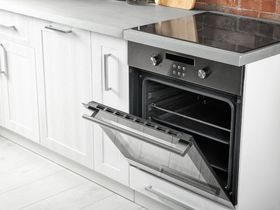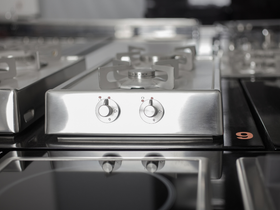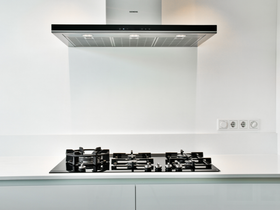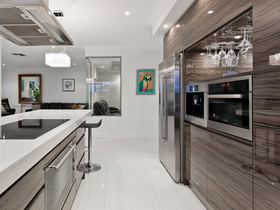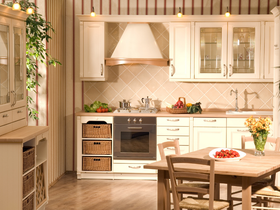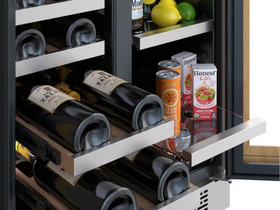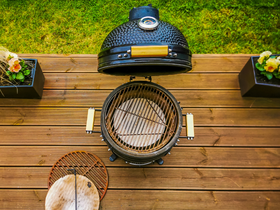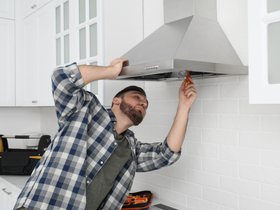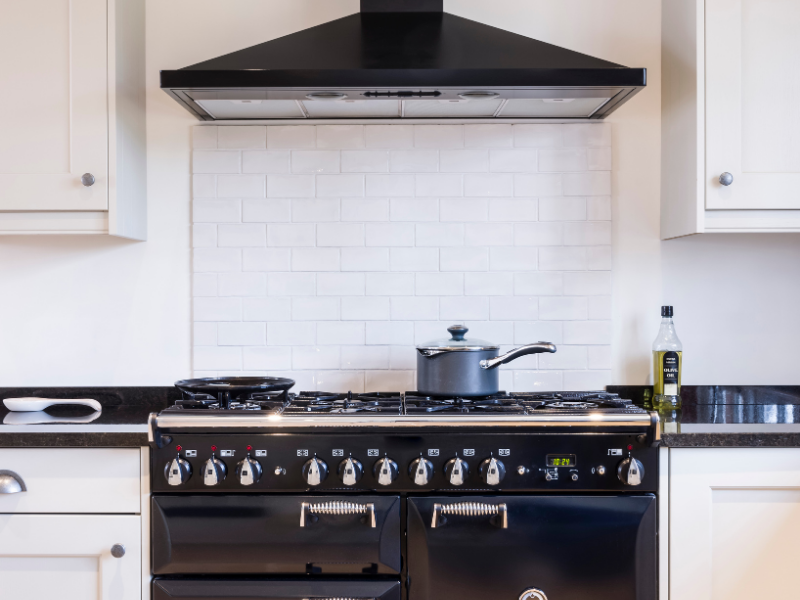
Kitchen Ventilation 101: What You Need to Know Before Buying a Range Hood
Choosing a range hood? Learn about ducted vs. ductless systems, CFM requirements, sizing, noise levels, and more in this beginner-friendly ventilation guide.
Introduction: Why Ventilation Matters
Let's talk about something that's probably not on your Pinterest board but absolutely should be in your kitchen planning: ventilation. While everyone gets excited about choosing the perfect range, the range hood often becomes an afterthought – until you're standing in a smoky kitchen wondering why your smoke alarm keeps going off every time you sear a steak.
Here's the thing: good kitchen ventilation isn't just about clearing smoke. It's about removing cooking odors, excess moisture that can damage cabinets, grease particles that coat everything, and even potentially harmful gases from gas cooking. Poor ventilation can lead to everything from lingering food smells to actual indoor air quality problems.
Too many people either skip the range hood entirely, choose one that's way underpowered for their cooking style, or pick something that looks great but doesn't actually do the job. We've seen gorgeous kitchens where the homeowner regrets their ventilation choices every single day.
This guide will walk you through everything you need to know to choose a range hood that actually works for your kitchen, your cooking style, and your space. We'll cover the basics of how different systems work, how to size them properly, and what features actually matter so you can cook with confidence and keep your kitchen air fresh.
Ducted vs. Ductless: What's the Difference?
This is the fundamental decision that affects everything else about your range hood choice. Let's break down both options so you understand what you're getting into.
A. Ducted (Vented) Range Hoods
How it works: Ducted hoods pull air from your cooking area and send it outside through ductwork that runs through your walls or ceiling. Think of it as a direct pipeline from your kitchen to the outdoors.
Why people choose ducted:
- Much more effective at removing smoke, steam, and odors
- Better for heavy cooking, especially with gas ranges
- No filter replacement costs for recirculation
- Handles high-heat cooking without breaking a sweat
The reality check: You need a path to the outside, which means planning ductwork through walls, ceilings, or roofs. This can get complex (and expensive) depending on your kitchen layout.
Best for: Gas ranges, frequent high-heat cooking, homes where you can run ductwork to an exterior wall or roof.
B. Ductless (Recirculating) Range Hoods
How it works: These hoods pull air through filters that capture grease and odors, then blow the cleaned air back into your kitchen. No ductwork required – they're self-contained units.
Why people choose ductless:
- Much easier installation (no ductwork needed)
- Works in apartments, condos, or kitchens with no exterior wall access
- Often less expensive to install
- Can be moved if you relocate
The reality check: They're simply not as effective as ducted systems. They can handle light cooking and some odors, but they struggle with heavy smoke or high-output gas ranges.
Best for: Light cooking, electric ranges, apartments, or situations where ductwork isn't feasible.
| Feature | Ducted | Ductless |
|---|---|---|
| Effectiveness | Excellent | Good for light cooking |
| Installation | Complex, requires ductwork | Simple, plug-and-play |
| Best For | Gas ranges, heavy cooking | Electric ranges, light cooking |
| Maintenance | Basic cleaning | Regular filter replacement |
| Cost | Higher upfront, lower ongoing | Lower upfront, higher ongoing |
How to Size Your Range Hood (CFM Basics)
CFM stands for "cubic feet per minute" – basically, how much air your hood can move. Getting this right is crucial because an underpowered hood won't keep up with your cooking, while an overpowered one can be unnecessarily noisy and expensive.
Basic Sizing Guidelines
For electric ranges: Plan for about 100 CFM per linear foot of cooktop width. So a 30-inch (2.5 feet) electric range would need around 250 CFM.
For gas ranges: You need more power because gas produces more heat and combustion byproducts. Plan for 100-150 CFM per linear foot, or calculate based on BTU output.
BTU-based calculation: For gas ranges, you can also calculate 1 CFM per 100 BTU of total burner output. A range with 60,000 total BTU would need around 600 CFM.
Real-World Examples
- Light cooking (occasional use, mostly electric): 200-400 CFM is usually sufficient Average home cooking: 400-600 CFM handles most situations well
- Heavy cooking or entertaining: 600-900 CFM for serious home chefs
- Professional-style ranges: 900+ CFM for high-BTU commercial-style equipment
Don't Oversize
While it might seem like "bigger is better," overly powerful hoods can create problems:
- Excessive noise that makes conversation impossible
- Can interfere with gas burner flames
- Higher energy costs
- May require makeup air systems in tightly sealed homes
Example: Let's say you have a 36-inch gas range with 65,000 total BTU. Using the BTU method, you'd need about 650 CFM. Using the width method (36" = 3 feet × 150 CFM), you'd need 450 CFM. Going with 600-650 CFM would be ideal – enough power without going overboard.
Noise Levels (Sones) and What's Tolerable
Nobody wants a range hood that sounds like a jet engine every time you cook. Noise levels are measured in sones, and understanding this can save you from a daily annoyance.
Sone Scale Reality Check
- 1-2 sones: Very quiet – similar to a refrigerator humming. Great for open kitchens or if you cook while others are watching TV nearby.
- 3-4 sones: Moderate noise – you can still have a conversation, but you might need to speak up slightly. This is the sweet spot for most kitchens.
- 5-6 sones: Noticeable noise – conversations become difficult, but it's manageable for short cooking periods.
- 7+ sones: Loud – think hair dryer or vacuum cleaner. Only acceptable if you rarely use the hood or have excellent soundproofing.
When Low Noise Matters Most
Open floor plans: If your kitchen flows into living areas, noise control becomes much more important.
Frequent cooking: If you cook daily or entertain often, investing in a quieter hood pays off quickly.
Early morning/late night cooking: Quiet operation matters if you cook when others are sleeping.
The CFM vs. Noise Trade-off
Generally, higher CFM means more noise, but quality hoods can move more air more quietly. Look for hoods that offer multiple speed settings so you can use lower, quieter settings for light cooking and ramp up the power only when needed.
Pro tip: Many hoods are quieter on lower settings but still provide adequate ventilation for everyday cooking. You don't always need to run them at maximum power.
Installation Styles & Placement
The style of range hood you choose depends on your kitchen layout, aesthetic preferences, and practical needs. Here's what you need to know about each type:
A. Wall-Mounted Range Hoods
- Best for: Ranges positioned against a wall (most common setup)
- Pros: Wide selection, relatively straightforward installation, good capture area
- Considerations: Need adequate wall space above the range, must work around any windows or cabinets
B. Under-Cabinet Range Hoods
- Best for: Kitchens with cabinets directly above the range
- Pros: Space-saving, often less expensive, integrates well with existing cabinetry
- Considerations: Limited to the size of your cabinet space, may have less powerful CFM options
C. Island Range Hoods (Ceiling-Mounted)
- Best for: Kitchen islands or peninsulas with ranges
- Pros: Creates a dramatic focal point, excellent access from all sides
- Considerations: More complex installation, requires ceiling-mounted ductwork, typically more expensive
D. Insert Hoods (Custom Panel Ready)
- Best for: Custom kitchens where you want the hood to blend seamlessly
- Pros: Can be completely hidden behind custom panels, maintains clean design lines
- Considerations: Requires custom cabinetry work, often the most expensive option
- Key Placement Rules
Height above cooktop: Generally 24-30 inches for gas ranges, 20-24 inches for electric. Check your specific hood's requirements as they can vary.
Width coverage: Your hood should be at least as wide as your cooktop, preferably 3-6 inches wider on each side for better capture.
Ductwork considerations: Plan the shortest, straightest path to the outside. Every turn and length of ductwork reduces efficiency.
Filters & Maintenance
Range hood filters are your first line of defense against grease and odors, but they only work if they're properly maintained. Here's what you need to know:
Types of Filters
Baffle filters: Made of metal (usually stainless steel) with angled channels that catch grease. They're dishwasher-safe and last for years with proper cleaning.
Mesh filters: Multi-layered metal screens that trap grease particles. Also dishwasher-safe, but may need more frequent cleaning.
Charcoal filters: Used in ductless hoods to filter odors. These need to be replaced every 3-6 months and can't be cleaned.
Maintenance Schedule
Monthly cleaning: For average cooking, clean metal filters monthly in the dishwasher or with warm, soapy water.
Heavy cooking: If you cook frequently or do a lot of frying, you might need weekly cleaning.
Signs filters need attention: Grease buildup you can see, reduced suction power, or lingering odors even with the hood running.
Don't Skip This Step
Dirty filters don't just reduce effectiveness – they can become fire hazards. Grease buildup can ignite, and clogged filters force your hood's motor to work harder, potentially shortening its lifespan.
Pro tip: Keep a spare set of filters so you can swap them out for cleaning without going without ventilation.
Features to Consider When Buying
Modern range hoods offer more than just basic ventilation. Here are the features worth considering:
Lighting
LED lighting: Energy-efficient, long-lasting, and provides excellent task lighting for cooking. Most new hoods include this as standard.
Brightness controls: Dimmable lights let you adjust based on whether you're cooking or just want ambient lighting.
Smart Features
Auto on/off: Sensors detect heat or smoke and automatically turn the hood on. Genuinely useful for forgetful cooks.
App integration: Control your hood from your phone, set timers, or get maintenance reminders. Nice to have but not essential.
Variable speed controls: Multiple speed settings let you match ventilation to your cooking intensity.
Convenience Features
Timer shut-off: The Hood automatically turns off after a set time. Great for when you start cooking and get distracted.
Delay shut-off: Continues running for a few minutes after you turn it off to clear remaining odors and steam.
Touch vs. button controls: Touch controls look sleek but can be harder to use with messy hands. Physical buttons might be more practical.
💡 Three Features That Make Life Easier:
- Multiple speed settings – match power to cooking intensity
- Good LED lighting – see what you're cooking clearly
- Dishwasher-safe filters – easy maintenance
One Feature That's Usually Overkill:
- Heat sensors with automatic adjustment – sounds great, but often turns on when you don't want it, and doesn't always match your actual needs
Matching Your Hood to Your Range
Getting the right hood for your specific range and cooking style is crucial for both performance and satisfaction.
For Gas Ranges
Higher CFM needs: Gas produces heat, moisture, and combustion byproducts that need powerful ventilation.
Professional-style considerations: High-BTU ranges often require commercial-grade ventilation and may need makeup air systems.
Safety factor: Proper ventilation for gas cooking isn't just about comfort – it's about indoor air quality and safety.
For Electric Ranges
Lower CFM acceptable: Electric ranges produce less heat and no combustion byproducts, so you can often get away with less powerful ventilation.
Induction specifics: Induction cooktops produce even less ambient heat, so ventilation needs are minimal unless you're doing high-heat cooking.
For Dual-Fuel Ranges
Plan for the gas cooktop: Size your ventilation based on the gas burners, not the electric oven. The cooktop produces the heat and combustion byproducts that need ventilation.
Kitchen Layout Considerations
Open floor plans: You might want higher CFM to prevent cooking odors from spreading to living areas.
Galley kitchens: Proper ventilation is even more critical in smaller spaces where odors and heat can become concentrated.
High ceilings: May need more powerful ventilation to effectively capture air before it disperses.
Shop With Confidence
Now that you understand the basics, here's how to make your final decision:
Questions to Ask Yourself
- Do I have access to exterior walls or roof for ductwork?
- How often do I cook, and what type of cooking do I do?
- Is noise a concern in my kitchen layout?
- What's my budget for both the hood and installation?
- Do I want this to be a design statement or blend in?
What to Ask When Shopping
- What's the actual CFM at different speed settings?
- What's the noise level (in sones) at the CFM I need?
- What type of filters does it use, and how often do they need cleaning/replacement?
- What are the exact installation requirements and clearances?
- Is this hood appropriate for my range's BTU output?
Red Flags to Avoid
- Hoods that seem underpowered for your range
- Great prices that don't include necessary ductwork or installation
- Hoods with poor reviews about noise or effectiveness
- Complicated smart features that might break and can't be repaired
Making the Investment Work
A good range hood should last 10-15 years with proper maintenance. It's worth investing in one that's appropriately sized and well-built rather than trying to save money with something that won't do the job.
Remember: the best range hood is one that you'll actually use because it's effective and not annoyingly loud. If you get the sizing and features right, it becomes an appliance you barely think about, which is exactly what you want.
Need Help Choosing the Right Range Hood?
Ventilation can get complex, especially if you're dealing with ductwork limitations, high-BTU ranges, or unique kitchen layouts. If you're feeling uncertain about CFM requirements, installation feasibility, or which style will work best for your space, our experts can help you sort through the options.
We've helped hundreds of customers match the right ventilation to their ranges and cooking styles. Whether you need help calculating CFM requirements, understanding installation options, or just want someone to double-check your plan, we're here to make sure you get ventilation that actually works.
Ready to breathe easy while you cook? Talk to our ventilation experts or explore our range hood collection to find the perfect match for your kitchen.


